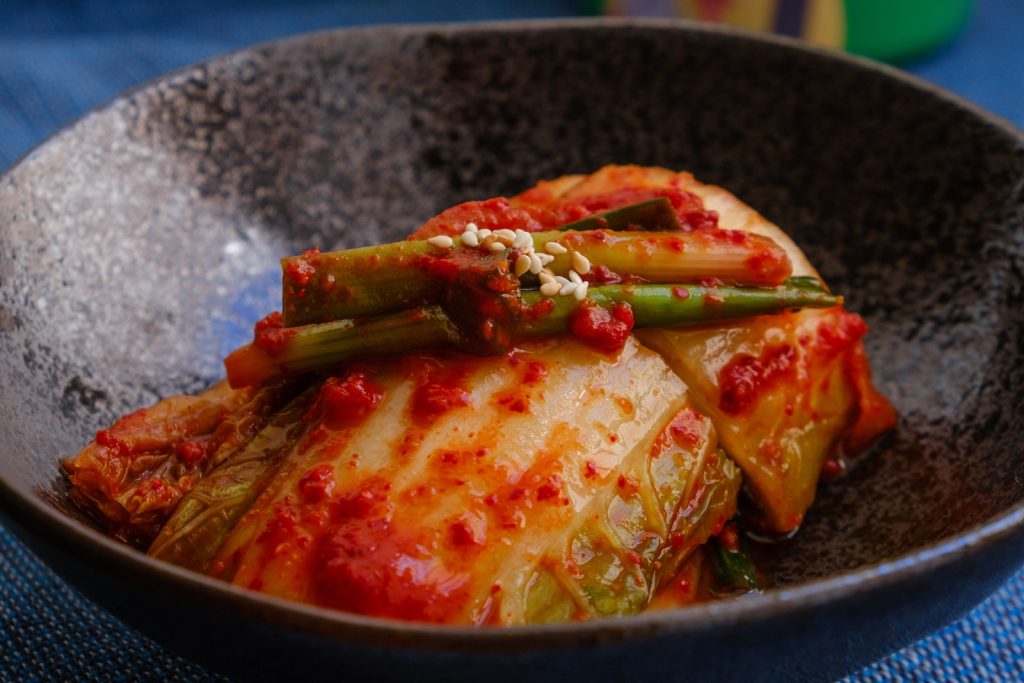Kimchi, a traditional Korean fermented dish, has become a global sensation for its unique combination of flavors, health benefits, and versatility. Making kimchi at home allows you to customize the ingredients to your taste and dietary preferences. This step-by-step guide will walk you through the process of creating a delicious and authentic homemade kimchi recipe.

1. Introduction:
Kimchi is a beloved Korean side dish made by fermenting vegetables with a blend of spices, creating a tangy, spicy, and umami-rich condiment. While traditional kimchi is made with Napa cabbage, variations using other vegetables are equally popular.
2. Ingredients and Equipment:
Ingredients:
- 1 large Napa cabbage
- 1/2 cup sea salt
- 1 tablespoon sugar
- 4 cups water
- 1 cup Korean radish or daikon radish (julienned)
- 1/2 cup carrots (julienned)
- 4 green onions (chopped)
- 1/2 cup Korean red pepper flakes (gochugaru)
- 1/4 cup fish sauce or soy sauce (for vegetarian/vegan version)
- 1/4 cup minced garlic
- 1 tablespoon minced ginger
- 1 tablespoon sugar
- 1 teaspoon salted shrimp paste (omit for vegetarian/vegan version)
Equipment:
- Large mixing bowls
- Cutting board and knife
- Gloves (for handling red pepper flakes)
- Airtight glass or plastic container for fermentation
- Weights or heavy objects
3. Preparing the Napa Cabbage:
- Cut the Napa cabbage in half lengthwise, and then cut each half into quarters.
- Dissolve 1/2 cup of sea salt in 4 cups of water to create a brine solution.
- Submerge the cabbage quarters in the brine, making sure they’re completely covered. Let them soak for 1-2 hours, turning occasionally.
- After soaking, rinse the cabbage thoroughly to remove excess salt. Gently squeeze out excess water.
4. Creating the Kimchi Paste:
- In a mixing bowl, combine the Korean red pepper flakes (gochugaru), minced garlic, minced ginger, fish sauce (or soy sauce), sugar, and salted shrimp paste (if using).
- Mix the ingredients into a thick paste. Use gloves to avoid direct contact with the red pepper flakes, as they can be quite spicy.
5. Layering and Fermentation:
- In a large mixing bowl, combine the julienned Korean radish, carrots, and chopped green onions.
- Spread the kimchi paste over the vegetables and mix thoroughly, ensuring even coating.
- Starting from the outer leaves, spread the kimchi paste between the cabbage layers, making sure to coat each leaf.
- Pack the kimchi into the airtight container, pressing it down to remove air bubbles. Use weights or heavy objects to keep the kimchi submerged in its own liquid.
6. Storing and Enjoying Kimchi:
- Seal the container and store it at room temperature for about 1-5 days to initiate fermentation. The time can vary based on desired level of fermentation.
- After the initial fermentation, store the kimchi in the refrigerator to slow down the fermentation process. The flavors will continue to develop over time.
7. Variations and Customizations:
- Experiment with different vegetables like cucumbers, radishes, or bok choy.
- Adjust the spiciness by varying the amount of red pepper flakes.
- Create a vegetarian or vegan version by omitting fish sauce and using soy sauce or other umami-rich ingredients.
8. Health Benefits of Kimchi:
- Kimchi is rich in probiotics that promote gut health.
- It contains antioxidants, vitamins, and minerals.
- The fermentation process enhances nutrient absorption.
- It may support immune function and digestion.
9. Cultural Significance and Culinary Exploration:
- Kimchi is a cornerstone of Korean cuisine and culture.
- Explore kimchi in traditional dishes like kimchi jjigae (stew) and kimchi bokkeumbap (fried rice).
- Embrace the art of fermentation and the connection between food and community.
Conclusion:
Making kimchi at home is a rewarding culinary experience that connects you to Korean tradition and the world of fermentation. By following this step-by-step guide, you’ll be able to create a flavorful and authentic kimchi that suits your taste preferences. Enjoy the process of crafting this beloved dish and savor the unique combination of tanginess, spice, and umami that defines kimchi’s charm.






